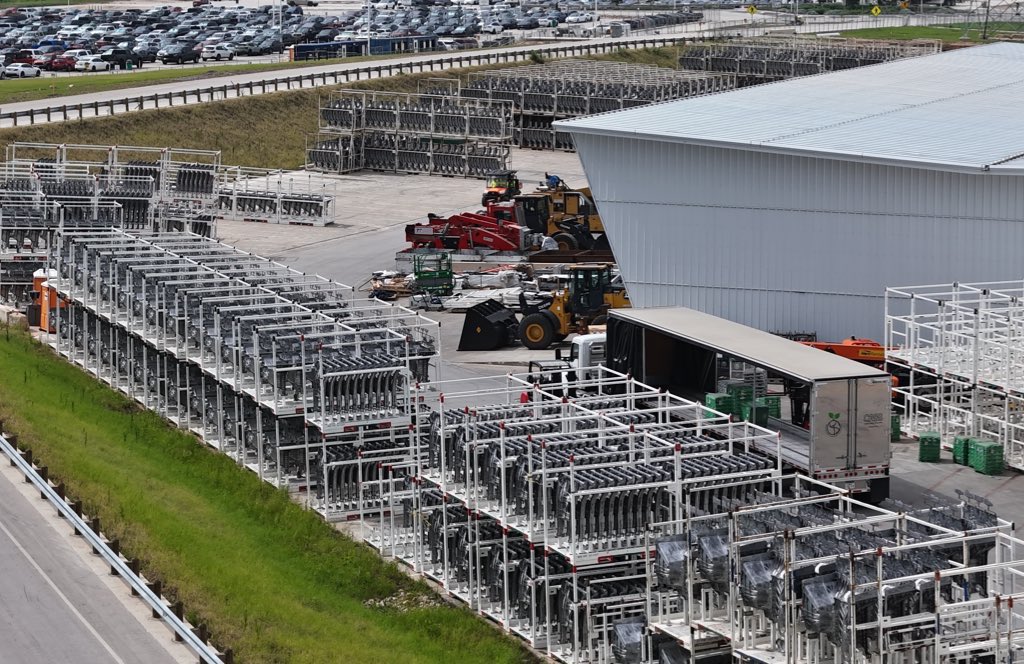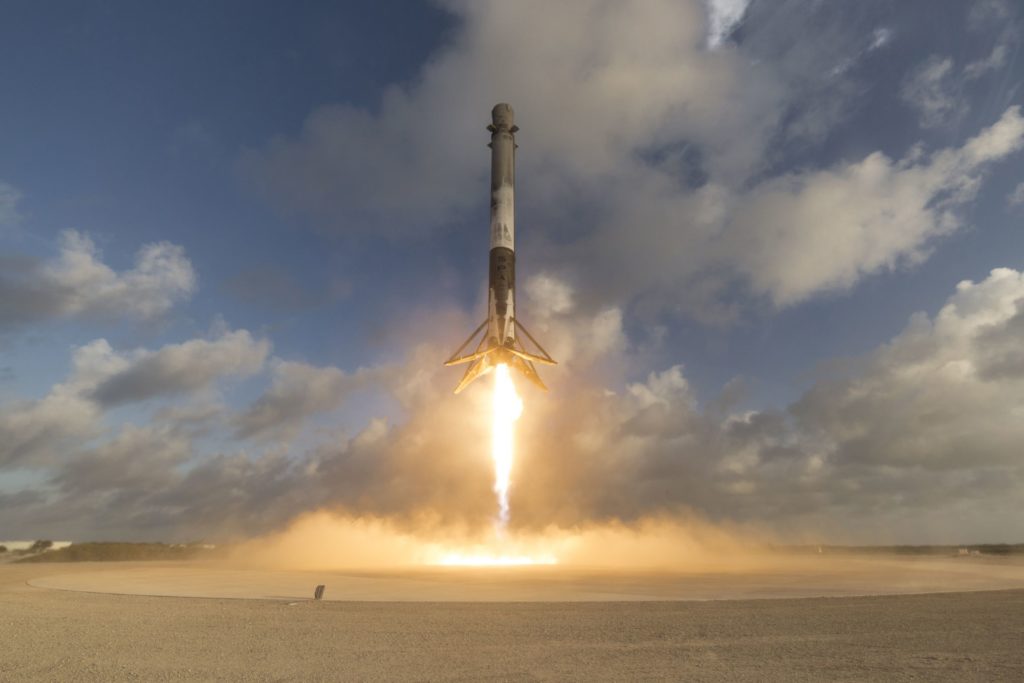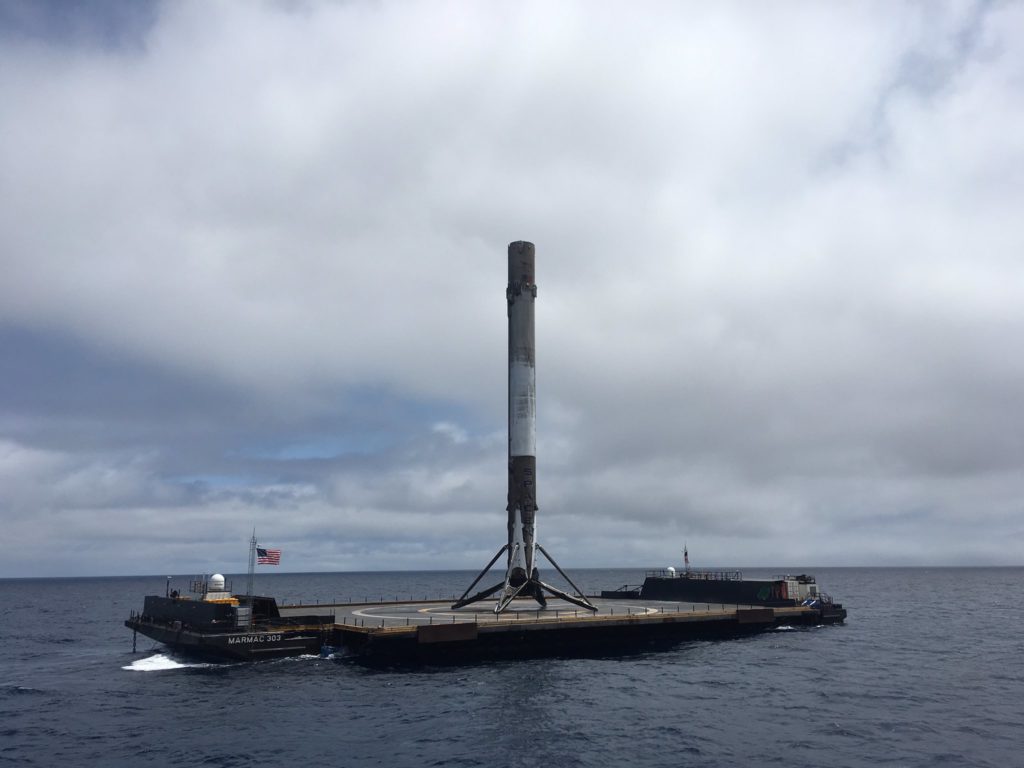

News
SpaceX on track to launch four rockets next month despite Falcon Heavy delays
Despite the intense focus on SpaceX’s first Falcon Heavy launch attempt and the testing preceding it, SpaceX is still a functioning business, and that business lies in launching payloads into Earth orbit. While it appears that January is unlikely to see any additional SpaceX launches, particularly Falcon Heavy, the launch company’s February manifest appears to be rapidly firming up.
Perhaps most significantly, two geostationary communications satellites completed their long journeys to Cape Canaveral, Florida within the last week or so, and a third payload on the West Coast is presumed to be at Vandenberg Air Force Base, all preparing for February launches. Meanwhile, although it is unclear how close Falcon Heavy is to launching, a date in mid to late February appears realistic at this point. As such, SpaceX has at least three and maybe four missions concretely planned for February – concrete in the sense that three of them were given specific launch dates within the last week.

Falcon Heavy is now targeting Friday, January 19 for its first static fire test. (Tom Cross/Teslarati)
A return to stride
Following a halcyon year of 18 launches, SpaceX appears to be ready to tackle its manifest headfirst after a relatively relaxed start to 2018. January saw a single SpaceX launch, Zuma, as well as the ongoing series of tests of the first completed Falcon Heavy launch vehicle, although the big rocket’s launch date has likely already slipped into February at the earliest. Still, SpaceX’s Falcon 9 workhorse rocket is rearing for additional launches, and options abound.
GovSat-1 (SES-16) – NET late January 2018
First on the docket is the launch of GovSat-1/SES-16, a public-private partnership between Luxembourg’s government and the renowned Lux.-based satellite manufacturer and operator, SES. Similar to Hispasat, GovSat-1 is a geostationary communications satellite weighing around 4000 kg that will be placed in a geostationary transfer orbit by Falcon 9. If it flies before Falcon Heavy, something I’d place at around 99% likely, the launch of PAZ will mark SpaceX’s first reused flight of 2018, with many, many more to come. This particular launch will use Core 1032 from the secretive NROL-76 mission back in May 2017. 1032 is an older booster, and thus a recovery attempt is unlikely – Block 3 Falcon 9s were never designed to be reused more than once or twice, especially not after toasty high-energy recoveries necessitated by geostationary launches.
- After launching NROL-76 in May 2017, B1032 returned to Landing Zone-1 for a successful landing. (SpaceX)
- SES and GovSats’ first partnered satellite, GovSat-1/SES-16. (SES)
PAZ – Starlink prototype co-passengers – NET February 10 2018, 6:52am PST
Up next, PAZ is a commercial imaging satellite designed to return high-resolution photos of Earth from a relatively low polar orbit of approximately 500 km. It’s believed that this mission will be launched aboard a flight-proven Falcon 9 booster, Core 1038, previously tasked with the launch of the small Formosat-5 imaging satellite in August 2017. The mission will be the second 2018 launch of a flight proven booster for SpaceX, following on the heels of GovSat-1. Perhaps more important than reuse (but secondary to the customer’s payload insertion), however, is the probable presence of two of SpaceX’s first prototype broadband satellites, a constellation now known to be called Starlink.
This will be a major achievement for SpaceX’s satellite constellation efforts, as the several hundred employees SpaceX has stationed in Washington State and outside of Hawthorne, CA will finally be able to operationally test the fruit of many months of hard but silent work. Given the presence of two satellites, it’s assumed that these test satellites, Microsat 2A and 2B, have been designed to test all of the main components SpaceX has been developing, particularly the optical (LASER) on orbit communications system. By allowing each satellite to communicate at incredibly high bandwidths with each other, SpaceX’s ultimate goal is to create a mesh network of connectivity covering the entire Earth.
As such, fingers crossed that SpaceX begins to discuss Starlink in more detail as 2018 progresses and PAZ and its Microsat co-passengers reach orbit in February. Sadly, although the combined payload is small and the planned orbit low, the twice-flight-proven booster may meet its ultimate fate in the Pacific Ocean – a recovery attempt is no longer guaranteed for older, reused Falcon 9s. However, while not officially confirmed, this launch could see the debut of SpaceX’s Western landing pad, currently known as SLC-4 West (SLC-4W). Rather than attempting recovery aboard the drone ship Just Read The Instructions, Falcon 9 1038 would instead flip around and return to a landing area less than a kilometer away from its VAFB launch pad. Expect official confirmation as the launch date approaches.
- The Spanish company Hisdesat’s PAZ imaging satellite. (Hisdesat)
- Falcon 9 1038 aboard Just Read The Instructions after the launch of Formosat-5. (SpaceX)
Hispasat 30W-6 (1F) – No Earlier Than (NET) mid-February 2018
Finally, Hispasat is a relatively hefty 6000 kg commercial communications satellite slated for launch aboard what is believed to be a new Falcon 9 rocket. With SpaceX aiming to place the satellite into a geostationary transfer orbit, this will almost certainly preclude any attempts at recovering the first stage – the booster will need to expend most of its fuel to accomplish the job, leaving no reserve to conduct landing burns at sea. Hispasat’s Falcon 9 will thus likely be the first new booster to be expended intentionally by SpaceX in 2018.
Spain's @Hispasat: 30W-6 telecom sat arrives at Cape Canaveral from builder @sslmda to prepare for Feb launch on @SpaceX Falcon 9. Sat carries Ku-, C- & Ka-band payload for Americas/trans-Atlantic. pic.twitter.com/Zfhi1cE5vx
— Peter B. de Selding (@pbdes) January 16, 2018
Another busy year?
If February is to be representative of SpaceX’s 2018 launch cadence, the year is going to be a crazy one for the rocket company. As of IAC 2017, Elon Musk showed an estimated 30 launches as the company’s goal this year, compared to 20 in 2017 (SpaceX was only two launches short of that). While Falcon Heavy may be understandably stealing the buzz and then some from those interested in spaceflight and technology, it is an absolute necessity that SpaceX remains a viable and reliable launch company if they hope to pursue more aspirational technologies like Falcon Heavy, BFR, and more. Here’s to hoping that SpaceX manages to make 2018 equally or even more successful than 2017.
Follow along live as launch photographer Tom Cross and I cover these exciting proceedings as close to live as possible.
Teslarati – Instagram – Twitter
Tom Cross – Instagram
Eric Ralph – Twitter
News
These Tesla, X, and xAI engineers were just poached by OpenAI
The news is the latest in an ongoing feud between Elon Musk and the Sam Altman-run firm OpenAI.

OpenAI, the xAI competitor for which Elon Musk previously served as a boardmember and helped to co-found, has reportedly poached high-level engineers from Tesla, along with others from xAI, X, and still others.
On Tuesday, Wired reported that OpenAI hired four high-level engineers from Tesla, xAI, and X, as seen in an internal Slack message sent by co-founder Greg Brockman. The engineers include Tesla Vice President of Software Engineering David Lau, X and xAI’s head of infrastructure engineering Uday Ruddarraju, and fellow xAI infrastructure engineer Mike Dalton. The hiring spree also included Angela Fan, an AI researcher from Meta.
“We’re excited to welcome these new members to our scaling team,” said Hannah Wong, an OpenAI spokesperson. “Our approach is to continue building and bringing together world-class infrastructure, research, and product teams to accelerate our mission and deliver the benefits of AI to hundreds of millions of people.”
Lau has been in his position as Tesla’s VP of Software Engineering since 2017, after previously working for the company’s firmware, platforms, and system integration divisions.
“It has become incredibly clear to me that accelerating progress towards safe, well-aligned artificial general intelligence is the most rewarding mission I could imagine for the next chapter of my career,” Lau said in a statement to Wired.
🚨Optimistic projections point to xAI possibly attaining profitability by 2027, according to Bloomberg's sources.
If accurate, this would be quite a feat for xAI. OpenAI, its biggest rival, is still looking at 2029 as the year it could become cash flow positive.💰 https://t.co/pE5Z9daez8
— TESLARATI (@Teslarati) June 18, 2025
READ MORE ON OPENAI: Elon Musk’s OpenAI lawsuit clears hurdle as trial looms
At xAI, Ruddarraju and Dalton both played a large role in developing the Colossus supercomputer, which is comprised of over 200,000 GPUs. One of the major ongoing projects at OpenAI is the company’s Stargate program,
“Infrastructure is where research meets reality, and OpenAI has already demonstrated this successfully,” Ruddarraju told Wired in another statement. “Stargate, in particular, is an infrastructure moonshot that perfectly matches the ambitious, systems-level challenges I love taking on.”
Elon Musk is currently in the process of suing OpenAI for shifting toward a for-profit model, as well as for accepting an investment of billions of dollars from Microsoft. OpenAI retaliated with a counterlawsuit, in which it alleges that Musk is interfering with the company’s business and engaging in unfair competition practices.
Elon Musk confirms Grok 4 launch on July 9 with livestream event
News
SpaceX share sale expected to back $400 billion valuation
The new SpaceX valuation would represent yet another record-high as far as privately-held companies in the U.S. go.

A new report this week suggests that Elon Musk-led rocket company SpaceX is considering an insider share sale that would value the company at $400 billion.
SpaceX is set to launch a primary fundraising round and sell a small number of new shares to investors, according to the report from Bloomberg, which cited people familiar with the matter who asked to remain anonymous due to the information not yet being public. Additionally, the company would sell shares from employees and early investors in a follow-up round, while the primary round would determine the price for the secondary round.
The valuation would represent the largest in history from a privately-owned company in the U.S., surpassing SpaceX’s previous record of $350 billion after a share buyback in December. Rivaling company valuations include ByteDance, the parent company of TikTok, as well as OpenAI.
Bloomberg went on to say that a SpaceX representative didn’t respond to a request for comment at the time of publishing. The publication also notes that the details of such a deal could still change, especially depending on interest from the insider sellers and share buyers.
Axiom’s Ax-4 astronauts arriving to the ISS! https://t.co/WQtTODaYfj
— TESLARATI (@Teslarati) June 26, 2025
READ MORE ON SPACEX: SpaceX to decommission Dragon spacecraft in response to Pres. Trump war of words with Elon Musk
SpaceX’s valuation comes from a few different key factors, especially including the continued expansion of the company’s Starlink satellite internet company. According to the report, Starlink accounts for over half of the company’s yearly revenue. Meanwhile, the company produced its 10 millionth Starlink kit last month.
The company also continues to develop its Starship reusable rocket program, despite the company experiencing an explosion of the rocket on the test stand in Texas last month.
The company has also launched payloads for a number of companies and government contracts. In recent weeks, SpaceX launched Axiom’s Ax-4 mission, sending four astronauts to the International Space Station (ISS) for a 14-day stay to work on around 60 scientific experiments. The mission was launched using the SpaceX Falcon 9 rocket and a new Crew Dragon capsule, while the research is expected to span a range of fields including biology, material and physical sciences, and demonstrations of specialized technology.
News
Tesla Giga Texas continues to pile up with Cybercab castings
Tesla sure is gathering a lot of Cybercab components around the Giga Texas complex.

Tesla may be extremely tight-lipped about the new affordable models that it was expected to start producing in the first half of the year, but the company sure is gathering a lot of Cybercab castings around the Giga Texas complex. This is, at least, as per recent images taken of the facility.
Cybercab castings galore
As per longtime drone operator Joe Tegtmeyer, who has been chronicling the developments around the Giga Texas complex for several years now, the electric vehicle maker seems to be gathering hundreds of Cybercab castings around the factory.
Based on observations from industry watchers, the drone operator appears to have captured images of about 180 front and 180 rear Cybercab castings in his recent photos.
Considering the number of castings that were spotted around Giga Texas, it would appear that Tesla may indeed be preparing for the vehicle’s start of trial production sometime later this year. Interestingly enough, large numbers of Cybercab castings have been spotted around the Giga Texas complex in the past few months.
Cybercab production
The Cybercab is expected to be Tesla’s first vehicle that will adopt the company’s “unboxed” process. As per Tesla’s previous update letters, volume production of the Cybercab should start in 2026. So far, prototypes of the Cybercab have been spotted testing around Giga Texas, and expectations are high that the vehicle’s initial trial production should start this year.
With the start of Tesla’s dedicated Robotaxi service around Austin, it might only be a matter of time before the Cybercab starts being tested on public roads as well. When this happens, it would be very difficult to deny the fact that Tesla really does have a safe, working autonomous driving system, and it has the perfect vehicle for it, too.
-

 Elon Musk1 week ago
Elon Musk1 week agoTesla investors will be shocked by Jim Cramer’s latest assessment
-

 News2 weeks ago
News2 weeks agoTesla Robotaxi’s biggest challenge seems to be this one thing
-

 Elon Musk1 day ago
Elon Musk1 day agoElon Musk confirms Grok 4 launch on July 9 with livestream event
-

 News2 weeks ago
News2 weeks agoWatch the first true Tesla Robotaxi intervention by safety monitor
-

 News5 days ago
News5 days agoTesla Model 3 ranks as the safest new car in Europe for 2025, per Euro NCAP tests
-

 Elon Musk2 weeks ago
Elon Musk2 weeks agoA Tesla just delivered itself to a customer autonomously, Elon Musk confirms
-

 Elon Musk2 weeks ago
Elon Musk2 weeks agoElon Musk confirms Tesla Optimus V3 already uses Grok voice AI
-

 Elon Musk2 weeks ago
Elon Musk2 weeks agoxAI welcomes Memphis pollution results, environmental groups push back























